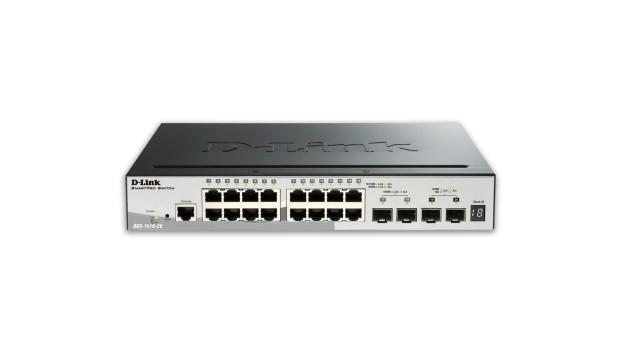The DGS-1510 Series is D-Link's latest generation of SmartPro switches with 10G port connectivity, making them ideal for deployment in SME/SMB core environments. The DGS-1510 Series provides a reliable, scalable, and modular interconnection between core switches and edge switches with rich capabilities and simplified flexibility. DGS-1510 switches include 2 Gigabit SFP ports and 2 10G SFP+ ports.
Two 10G SFP+ Stacking/Uplink Ports
Depending on whether linear or fault-tolerant ring stacking is implemented, users can use one or two 10-Gigabit SFP+ ports to create a physical stack. Six units or 288 Gigabit ports can be configured as a stack using optional direct attach cables to provide high bandwidth on the DGS-1510 Series with cost efficiency. Users can mix from any of the DGS-1510 SmartPro series in a single stack to allow simultaneous and easy configuration, management and troubleshooting.
Static routing is also available on SmartPro switches together with other more advanced networking and management features, incorporating Green Ethernet technology for reliable and eco-friendly operation.
Flexibility and Scalability
The DGS-1510 Series supports virtual stacking via D-Link's Single IP Management (SIM), allowing up to 32 devices to be managed via a single IP. This simplifies management of small workgroups or wiring closets while allowing the network to be scaled to handle increased bandwidth demand. SIM reduces the number of IP address needed in the network and allows switches to be stacked together over Ethernet instead of using physical uplink or stacking ports. This eliminates the need for specialized stacking cables and removes distance barriers that can limit topology options when using other stacking technology.
Extensive Layer 2 Features
The DGS-1510 Series switches are equipped with a complete lineup of Layer 2 features including IGMP Snooping, Port Mirroring, Spanning Tree, and Link Layer Discovery Protocol (LLDP). The IEEE 802.3x Flow Control function allows servers to directly connect to the switch for fast, reliable data transfer. At 2000 Mbps Full Duplex, the Gigabit ports provide high-speed data pipes to servers with minimum data transfer loss. Network maintenance features include Loopback Detection and Cable Diagnostics. Loopback Detection is used to detect loops created by a specific port or VLAN and automatically shut down the affected port or VLAN. The Cable Diagnostics feature, designed primarily for administrators and customer service representatives, can quickly discover the type of error on cables and determine the cable quality.
Layer 3 Traffic Management
The DGS-1510 Series supports advanced traffic management features, including static routing. In static routing, IP routes are manually entered into a routing table, which allows for communication between different user groups in different VLAN segments in a network. The switch can directly handle inter VLAN routing using multiple interfaces, making the network run faster and more efficiently. Because the switches can manage internal routing, the network router can be assigned to handle external traffic routing only.
QoS, Bandwidth Control
The DGS-1510 Series supports Auto Surveillance VLAN (ASV) and Auto Voice VLAN, which are best suited for VoIP and video surveillance deployments. Auto Surveillance VLAN is a new, industry-leading technology built into D-Link Smart Switches. This technology consolidates data and surveillance video transmission through a single SmartPro switch, sparing businesses the expense of maintaining expensive dedicated hardware and facilities. ASV also ensures the quality of real-time video for monitoring and control without compromising the transmission of conventional network data. The Auto Voice VLAN technology enhances VoIP service by automatically placing voice traffic from an IP phone to an assigned VLAN. With higher priority and an individual VLAN, these features guarantee the quality and security of VoIP traffic. Furthermore, the DSCP markings on Ethernet packets enable different levels of service to be assigned to network traffic. As a result, these voice and video packets take precedence over other packets. In addition, with Bandwidth Control, network administrators can reserve bandwidth for important functions that require more bandwidth or might require high priority.

